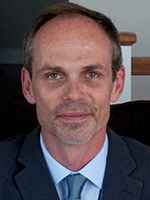Dr. Rupert Kaul
Immune Correlates of HIV Susceptibility
University of Toronto, Toronto General Hospital
 Dr. Rupert Kaul, Professor at University of Toronto and Physician at Toronto General Hospital, became interested in HIV research soon after completing his Infectious Disease clinical training. For his initial research exposure, Dr. Kaul travelled to Nairobi where he studied a population of HIV resistant sex workers in Nairobi under the supervision of Dr. Frank Plummer from Winnipeg, and the linkage between STD prevention and HIV in a separate cohort with Dr. Stephen Moses. Pragmatic in his approach to research, it was the logistics of HIV transmission that led him to his current area of study. "When you are in the field and you are studying sexual HIV transmission in people, I think it's logical to start looking at genital immunology and semen" Dr. Kaul explains. Today, Dr. Kaul's research investigates the immune correlates of HIV susceptibility and transmission in cohorts of people from Canada, Uganda and Kenya.
Dr. Rupert Kaul, Professor at University of Toronto and Physician at Toronto General Hospital, became interested in HIV research soon after completing his Infectious Disease clinical training. For his initial research exposure, Dr. Kaul travelled to Nairobi where he studied a population of HIV resistant sex workers in Nairobi under the supervision of Dr. Frank Plummer from Winnipeg, and the linkage between STD prevention and HIV in a separate cohort with Dr. Stephen Moses. Pragmatic in his approach to research, it was the logistics of HIV transmission that led him to his current area of study. "When you are in the field and you are studying sexual HIV transmission in people, I think it's logical to start looking at genital immunology and semen" Dr. Kaul explains. Today, Dr. Kaul's research investigates the immune correlates of HIV susceptibility and transmission in cohorts of people from Canada, Uganda and Kenya.
Working with clinics in Uganda that are performing voluntary circumcision to reduce HIV risk in men, Dr. Kaul and his colleagues are researching immunological components found in foreskin tissue. With support from the Canadian Institutes of Health Research, part of this study looked at samples taken from men who have an HIV positive female partner yet have not contracted HIV themselves. The research has found both 'dampened down' T cell activation in the foreskin, and the presence of IgA, which is able to neutralize HIV. "One of the things we are trying to work out is where that IgA is coming from and its specificity," says Dr. Kaul. "It seems to be a strong correlate of protection against HIV, so we're quite excited." Over the next year, the study will try to tease out a little more about the role of IgA in foreskin with the goal of informing vaccine development.
Dr. Kaul and his colleagues have also been working on a study in Canada that looks at the levels of HIV in semen after treatment with antiretrovirals, and their results have public health implications. Research has shown that antiretroviral therapy is associated with a significant reduction in HIV transmission risk and a rapid reduction of HIV levels in the blood— but it may be a different story with semen. "Over the first few months that someone is on therapy, sometimes we see, despite being undetectable in blood, very high levels of virus in semen," explains Dr. Kaul. This phenomenon appears to be associated with immune activation in semen, triggering localized HIV activation and shedding. "This is seen in about 10 to 15% of men, and it can be infectious in vitro. We think this probably explains why we see an occasional case of transmission early when someone starts on therapy in clinical trials." Dr. Kaul adds that, based on these results, he would recommend that his patients practice protected sex for at least several months after starting treatment to reduce the risk of transmission.
As an HIV doctor, Dr. Kaul enjoys the direct applicability of his research. And while his research informs his practice, his patients provide him with valuable feedback. "It's interesting to hear their take on what they think is relevant in terms of HIV transmission and what they think is going to be doable or not doable in terms of interventions," says Dr. Kaul. "I like to hear what their current problems are around some of the paradigms of HIV prevention." As a critical part of HIV prevention, Dr. Kaul advocates strongly for treatment and feels that this needs support from patients, governments and the public.
The Canadian Association for HIV Research (CAHR), the CIHR HIV/AIDS Research Initiative, the Canadian Foundation for AIDS Research (CANFAR), the CIHR Canadian HIV Trials Network (CTN) and the Canadian HIV Vaccine Initiative (CHVI) Research and Development Alliance Coordinating Office (ACO) would like to thank Dr. Kaul and his colleagues for their significant contributions to our understanding of HIV. Their work is part of a larger Canadian effort that is making a difference in the lives of those affected by HIV in Canada and around the world.
- Date modified: